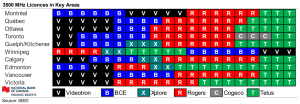The future of the future of work
Remote working was supposed to be part of the future of work.
As the pandemic forced many offices to transition to working from home, we asked if networks could handle the shift in online traffic. Many offices were completely closed during the first year or so following the declaration of a pandemic. It turned out that the networks performed pretty well. The future of work had arrived.
And, a lot of people got used to the idea of working from home. Hours of commuting time were eliminated, as well as savings in travel costs and parking. Some people (and some jobs) adapted well to working from home. Some people vacated expensive downtown housing and escaped to lower cost suburban and rural locations.
Others didn’t (or couldn’t) adapt as well.
Despite remote work collaboration tools, many companies found drops in productivity when staff weren’t able to meet face-to-face for problem solving. A recent article in the Globe and Mail examined “The remote work revolution that never took off”. Remote working, a prediction by those planning the future of work, is characterized as a privilege or benefit, not a right.
Employment lawyer Howard Levitt writes:
As a result of pandemic safety precautions, forced closures and stay-at-home orders, employees were permitted or required to work from their homes. Employers can order their employees back to work when those conditions end.
What if they do not? At some point, and we are getting there, employees who are working remotely will be able to take the position that remote work has become a term of their employment and that their employer can no longer order them back to work.
Can an employer force employees to return to the office? In most cases, yes. But, market conditions can play a role in that answer. For some types of work, especially professions with limited qualified candidates, employees are in a better position to dictate the terms of employment.
Some employees relocated. If remote work is an option, why not avoid the cost of living in urban areas? Still, employers can reasonably have policies to expect employees to remain in the same province, to avoid unintentionally being subjected to laws of a different jurisdiction.
In January 2022, roughly a quarter (24%) of Canadians worked exclusively from home. By December 2022, that fell to one in six (16%). “In that period, the proportion of workers with hybrid arrangements rose from 3.6 per cent to 9.6 per cent” according to Statistics Canada data collected by the Globe and Mail. “A hybrid model can be useful for time management… On office days, a worker can attend meetings, presentations and lunches, while on home days they can do work that requires deeper concentration.”
More work is required to address corporate culture in a remote work environment. How do employees develop company loyalty if they don’t regularly come into a company facility?
The CEO of Royal Bank recently said that the slow pace of employees returning to offices is impacting productivity and innovation. “I think all CEOs in every sector I talk to are struggling with the balance of attracting, retaining, developing talent, promoting talent, building culture, creating productivity, it’s tough. It’s really tough. We don’t have the final model yet.”
In the meantime, the future of the “Future of Work” is leaning toward a hybrid model. Last weekend, in the Toronto Star, David Olive wrote,
Fixating on where employees work is missing the point. The point is the long-simmering worker dissatisfaction unleashed at the end of the pandemic.
…
In ideal offices, respectful managers extend to employees the kind of autonomy they had while working from home.
…
What has been lost so far in the workplace transition is a focus on the basic questions: “Do you value your job? And does your employer value you?”
What does work look like in your company? Toward what direction are you heading?


